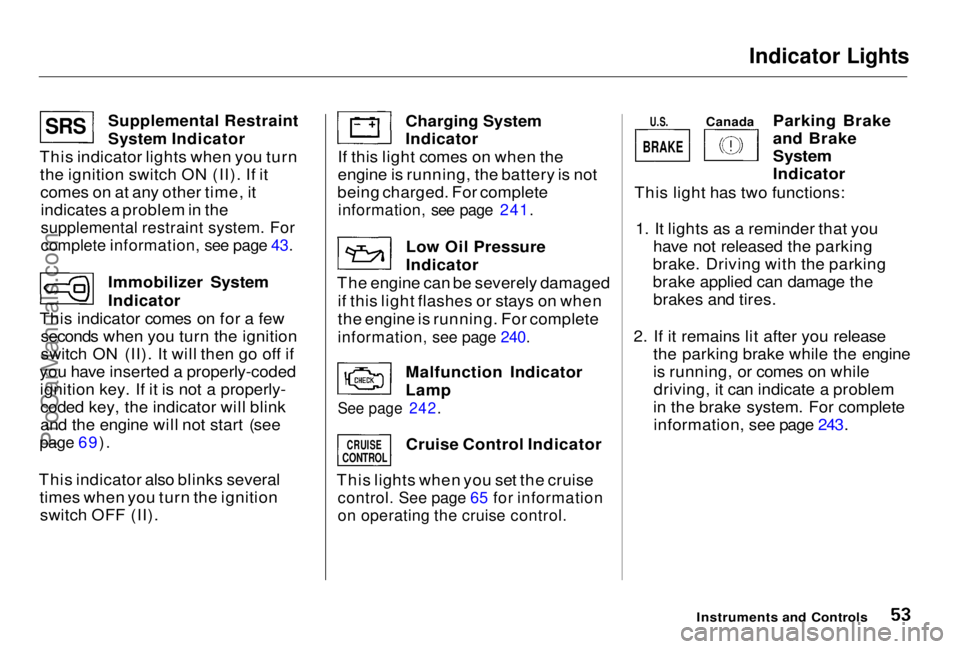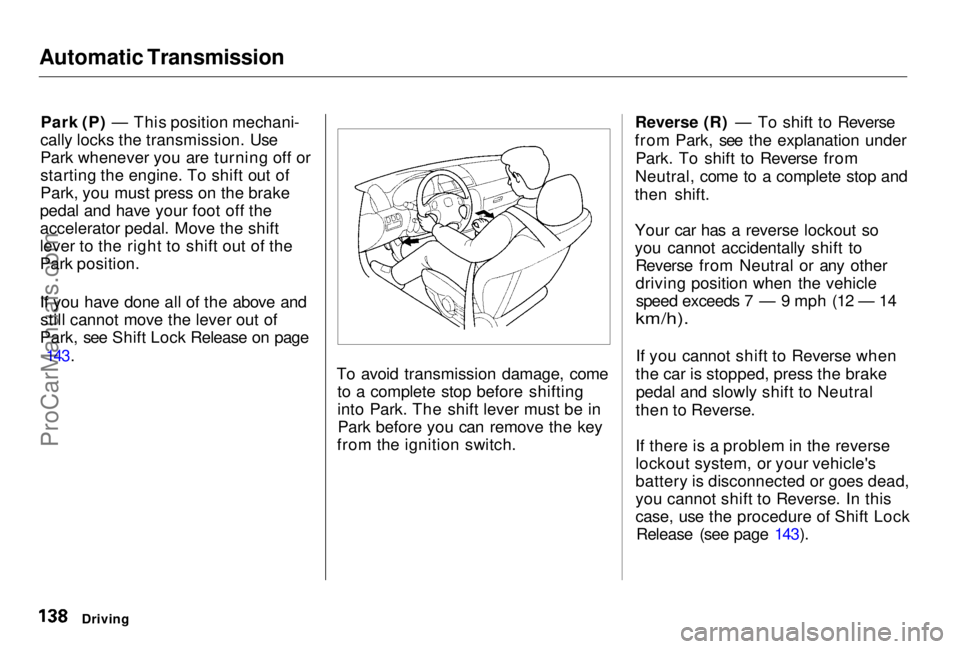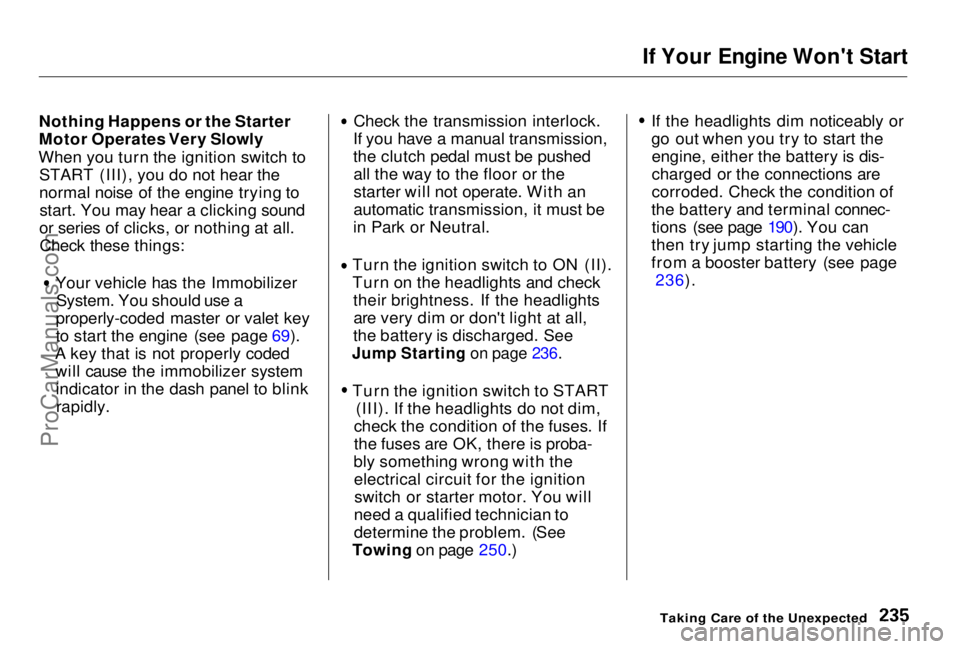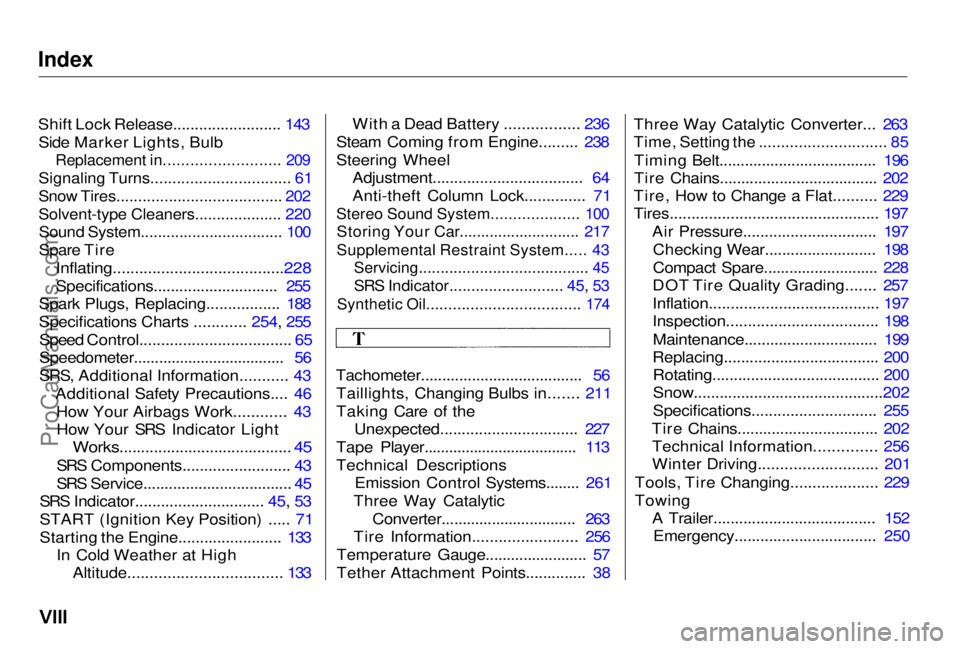key battery HONDA PRELUDE 1998 Owners Manual
[x] Cancel search | Manufacturer: HONDA, Model Year: 1998, Model line: PRELUDE, Model: HONDA PRELUDE 1998Pages: 278, PDF Size: 2.61 MB
Page 54 of 278

Indicator Lights
Supplemental Restraint
System Indicator
This indicator lights when you turn the ignition switch ON (II). If itcomes on at any other time, itindicates a problem in the
supplemental restraint system. For
complete information, see page 43.
Immobilizer System
Indicator
This indicator comes on for a few seconds when you turn the ignition
switch ON (II). It will then go off if
you have inserted a properly-coded ignition key. If it is not a properly-coded key, the indicator will blink
and the engine will not start (see
page 69).
This indicator also blinks several times when you turn the ignitionswitch OFF (II). Charging System
Indicator
If this light comes on when the
engine is running, the battery is not
being charged. For complete
information, see page 241.
Low Oil Pressure
Indicator
The engine can be severely damaged if this light flashes or stays on when
the engine is running. For complete
information, see page 240.
Malfunction Indicator
Lamp
See page 242.
Cruise Control Indicator
This lights when you set the cruise
control. See page 65 for information
on operating the cruise control.
Parking Brake
and Brake
System
Indicator
This light has two functions:
1. It lights as a reminder that you have not released the parking
brake. Driving with the parking
brake applied can damage the brakes and tires.
2. If it remains lit after you release the parking brake while the engine
is running, or comes on whiledriving, it can indicate a problem
in the brake system. For complete information, see page 243.
Instruments and Controls
S R S
BRAKE
CRUISE
CONTROL
U.S.
Canada
ProCarManuals.comMain Menu Table of Contents s t
Page 133 of 278

Starting the Engine
1. Apply the parking brake.
2. In cold weather, turn off all electrical accessories to reduce
the drain on the battery.
3. Manual Transmission:
Push the clutch pedal down all the
way. START (III) does not
function unless the clutch pedal is
depressed.
Automatic Transmission:
Make sure the shift lever is in
Park. Press on the brake pedal.
4. Without touching the accelerator pedal, turn the ignition key to the
START (III) position. If the engine
does not start right away, do not
hold the key in START (III) for
more than 15 seconds at a time.
Pause for at least 10 seconds
before trying again. 5. If the engine does not start within
15 seconds, or starts but stalls
right away, repeat step 4 with the
accelerator pedal pressed half-way
down. If the engine starts, release
pressure on the accelerator pedal
so the engine does not race.
6. If the engine still does not start, press the accelerator pedal all the
way down and hold it there while
starting in order to clear flooding.
As before, keep the ignition key in
the START (III) position for no
more than 15 seconds. Return to
step 5 if the engine does not start.
If it starts, lift your foot off the
accelerator pedal so the engine
does not race.
Starting in Cold Weather at High
Altitude (Above 8,000 feet/ 2,400 meters)
An engine is harder to start in cold
weather. The thinner air found at high altitude above 8,000 feet (2,400 meters) adds to the problem.
Use the following procedure:
1. Turn off all electrical accessories to reduce the drain on the battery.
2. Push the accelerator pedal half- way to the floor and hold it there
while starting the engine. Do nothold the ignition key in START (III) for more than 15 seconds.
When the engine starts, release the accelerator pedal gradually as
the engine speeds up and smooths out.
3. If the engine fails to start in step 2, push the accelerator pedal to the
floor and hold it there while you
try to start the engine for no morethan 15 seconds. If the enginedoes not start, return to step 2.
DrivingProCarManuals.comMain Menu Table of Contents s t
Page 138 of 278

Automatic Transmission
Park (P) — This position mechani-
cally locks the transmission. Use
Park whenever you are turning off or
starting the engine. To shift out of
Park, you must press on the brake
pedal and have your foot off the
accelerator pedal. Move the shift
lever to the right to shift out of the
Park position.
If you have done all of the above and still cannot move the lever out of
Park, see Shift Lock Release on page
143.
To avoid transmission damage, cometo a complete stop before shifting
into Park. The shift lever must be inPark before you can remove the key
from the ignition switch. Reverse (R) — To shift to Reverse
from Park, see the explanation under Park. To shift to Reverse from
Neutral, come to a complete stop and
then shift.
Your car has a reverse lockout so
you cannot accidentally shift to Reverse from Neutral or any other
driving position when the vehiclespeed exceeds 7 — 9 mph (12 — 14
km/h).
If you cannot shift to Reverse when
the car is stopped, press the brake pedal and slowly shift to Neutral
then to Reverse.
If there is a problem in the reverse
lockout system, or your vehicle's
battery is disconnected or goes dead,
you cannot shift to Reverse. In this
case, use the procedure of Shift Lock Release (see page 143).
DrivingProCarManuals.comMain Menu Table of Contents s t
Page 232 of 278

If Your Engine Won't Start
Nothing Happens or the Starter
Motor Operates Very Slowly
When you turn the ignition switch to START (III), you do not hear the
normal noise of the engine trying tostart. You may hear a clicking sound
or series of clicks, or nothing at all. Check these things: Your vehicle has the Immobilizer
System. You should use a
properly-coded master or valet key
to start the engine (see page 69).
A key that is not properly coded will cause the immobilizer systemindicator in the dash panel to blinkrapidly. Check the transmission interlock.
If you have a manual transmission,
the clutch pedal must be pushed all the way to the floor or the
starter will not operate. With an
automatic transmission, it must be
in Park or Neutral. Turn the ignition switch to ON (II).
Turn on the headlights and check
their brightness. If the headlightsare very dim or don't light at all,
the battery is discharged. See
Jump Starting on page 236.
Turn the ignition switch to START
(III). If the headlights do not dim,
check the condition of the fuses. If
the fuses are OK, there is proba-
bly something wrong with the electrical circuit for the ignitionswitch or starter motor. You will
need a qualified technician to
determine the problem. (See
Towing on page 250.) If the headlights dim noticeably or
go out when you try to start the
engine, either the battery is dis-
charged or the connections are
corroded. Check the condition of
the battery and terminal connec- tions (see page 190). You can
then try jump starting the vehicle
from a booster battery (see page
236).
Taking Care of the UnexpectedProCarManuals.comMain Menu Table of Contents s t
Page 276 of 278

Index
Shift Lock Release......................... 143
Side Marker Lights, Bulb
Replacement in.......................... 209
Signaling Turns................................ 61
Snow Tires...................................... 202
Solvent-type Cleaners.................... 220
Sound System................................. 100
Spare Tire
Inflating.......................................228
Specifications............................. 255
Spark Plugs, Replacing................. 188
Specifications Charts ............ 254, 255
Speed Control................................... 65
Speedometer.................................... 56
SRS, Additional Information........... 43 Additional Safety Precautions.... 46How Your Airbags Work............ 43How Your SRS Indicator Light
Works........................................ 45
SRS Components......................... 43
SRS Service................................... 45
SRS Indicator.............................. 45, 53
START (Ignition Key Position) ..... 71
Starting the Engine........................ 133 In Cold Weather at HighAltitude................................... 133 With a Dead Battery ................. 236
Steam Coming from Engine......... 238
Steering Wheel Adjustment................................... 64
Anti-theft Column Lock.............. 71
Stereo Sound System.................... 100
Storing Your Car............................ 217
Supplemental Restraint System..... 43
Servicing....................................... 45
SRS Indicator.......................... 45, 53
Synthetic Oil................................... 174
Tachometer...................................... 56 Taillights, Changing Bulbs in....... 211
Taking Care of the Unexpected................................ 227
Tape Player..................................... 113
Technical Descriptions Emission Control Systems........ 261
Three Way Catalytic Converter................................ 263
Tire Information........................ 256
Temperature Gauge........................ 57
Tether Attachment Points.............. 38 Three Way Catalytic Converter... 263
Time, Setting the ............................. 85
Timing Belt..................................... 196
Tire Chains..................................... 202
Tire, How to Change a Flat.......... 229
Tires................................................ 197
Air Pressure............................... 197Checking Wear.......................... 198
Compact Spare........................... 228
DOT Tire Quality Grading....... 257
Inflation....................................... 197
Inspection................................... 198
Maintenance............................... 199
Replacing.................................... 200 Rotating....................................... 200
Snow............................................202
Specifications............................. 255
Tire Chains................................. 202 Technical Information.............. 256
Winter Driving........................... 201
Tools, Tire Changing.................... 229
Towing A Trailer...................................... 152Emergency................................. 250ProCarManuals.comMain Menu s t